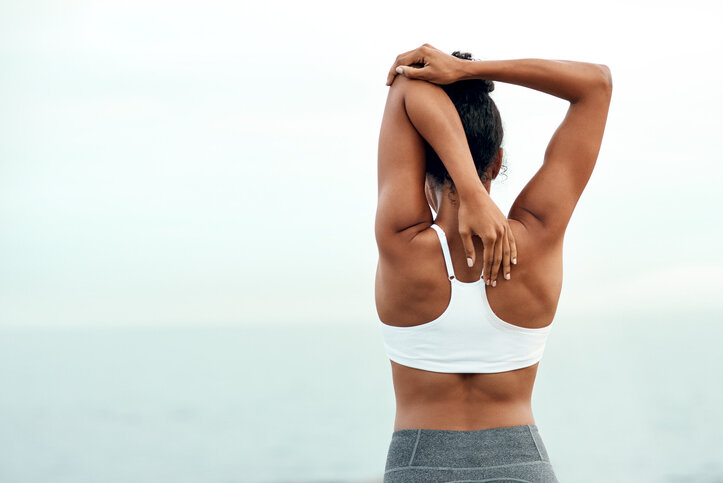Improve artery health with static stretching
/Improve artery health with static stretching
Over the years, stretching has been considered a necessary part of warming up and cooling down before and after exercise. The idea is to perform easy, gentle movements getting the blood circulating in preparation of active exercise and then to wind down the body after a workout. Stretching is still considered a vital part of any workout routine but here’s another benefit: Static-passive stretching of the lower leg muscles may improve the health of your arteries.
What is static stretching?
Advised and practiced over the years is common static stretching. Also called static-passive or relaxed stretching, this type of stretching was the predominant form used during the 1960s to the late 1990s, taught by coaches and fitness professionals to use before and after vigorous activity.
Static stretching is a type of stretch many of us probably did in middle school PE class – elongating a muscle by holding it up to 30 seconds or longer. Think side bends or the classic hamstring stretch where you reach for your toes while sitting on the floor. It’s been the most common form of stretching used in physical activity and has been the gold standard for safety and overall effectiveness for improving flexibility and reducing injury.
Static stretching also involves applying external force on muscles such as using your hand(s) to hold up a leg or to use an accessory apparatus such as an elastic band, yoga strap, wall, or the ground, or even a partner or physical therapist holding a body part to help stretch it.
When performing static stretching, it requires you to move a muscle to the end of its range of motion and to maintain that position without pain for 20 to 45 seconds. It’s an effective way to increase flexibility. However, it’s advised that static stretching should only be done after athletic activity, during cool-down to help prevent injury. If static stretching is done before an athletic event, it may actually negatively impact athletic performance since it may limit your body’s ability to react quickly.
How does static stretching improve artery health?
An Italian study published in the Journal of Physiology, had healthy adult people do a series of passive stretching exercises targeting the knee and ankle extensor muscles five days a week for 12 weeks. The stretches were each held for 45 seconds, with 15 seconds of rest in-between and were done five times on one side of the body and then repeated on the other side of the body.
A second group of healthy adults in this same study performed no stretching at all during this time.
Results from the study showed that compared to the no-stretching control group, the people in the passive stretching group showed improvements in vascular function – indicated by increased dilation and blood flow in certain arteries – arterial stiffness and blood pressure. This movement also showed improvements in increased range of motion in knee and ankle joints. Many of these positive effects lasted for at least six weeks follow-up. This suggests that performing this type of passive or static stretching had both local and systemic vascular effects.
The researchers with the study believe that these improvements from static stretching may be due to positive effects on the sympathetic nervous system, including the release of endogenous vasoactive substances causing blood vessels to dilate and constrict, and that there may be remodeling of the arterial vessel walls directly.
Stretching is good all the way around
No one would deny the benefits of stretching. Even if you are not participating in athletic events or doing vigorous exercise, regular static stretching has many benefits which include the following:
· Increases range of motion in joints
· Enhances flexibility
· Improves circulation
· Reduces risk of injury
· Increases blood flow to the muscles
· Improves walking ability in the elderly and those with peripheral artery disease
· Improves mobility for people with diabetes who have nerve damage
· Keeps connective tissue from tightening up as we age
Suggestions by fitness experts recommend when doing static stretching to always remember symmetry or to make sure when you stretch one side of the body, be sure to do the same with the other side. This prevents muscle imbalance. Also it’s recommended to do antagonistic muscle pairing – as an example, if you stretch out the front side of your legs or the quadriceps, be sure to also stretch out the backside of the legs or the hamstrings.
Static or passive stretching can be done at home on your own or you can work with a physical therapist to learn the correct form to use. It’s advised to start slowly, and don’t stretch a muscle that has been injured without getting medical advice first.
To get a better idea of examples of static stretching, click here.
Dr. David Samadi is the Director of Men’s Health and Urologic Oncology at St. Francis Hospital in Long Island. He’s a renowned and highly successful board certified Urologic Oncologist Expert and Robotic Surgeon in New York City, regarded as one of the leading prostate surgeons in the U.S., with a vast expertise in prostate cancer treatment and Robotic-Assisted Laparoscopic Prostatectomy. Visit Dr. Samadi’s websites at robotic oncology and prostate cancer 911.

